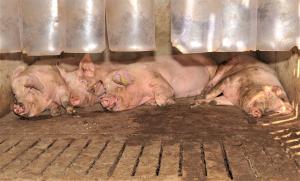Can pig behaviour be used to detect stomach ulcers?
Date published:
Research conducted between the Agri-Food and Biosciences Institute and Queens University, Belfast has found that stomach ulcers may cause changes in the way pigs rest, or may be the result of such changes.

Therefore, changes in behaviour might enable detection of ulcers before serious damage occurs. Also, pigs with stomach ulcers were found to be less prone to perform harmful behaviours like tail biting.
Stomach ulcers are an important pathological condition in pig farming. Research in several European countries suggests that approximately 20% of slaughtered pigs have mild ulcers, whilst another 10% have severe ulcers. Blood loss due to ruptured stomach ulcers can be the main cause of mortality on some pig farms (with 5-27% of all mortality attributed to stomach ulceration in some studies). In less acute cases blood loss may result in anaemic, unthrifty pigs. Even when blood loss is minimal, scar tissue formed as an ulcer heals may restrict a pig’s feed intake capacity, thus reducing growth. Both the ulcers themselves and their secondary effects are likely to cause pain or discomfort to pigs. This will not only affect their welfare, but may also impact on their behaviour. If such changes in behaviour can be detected at an early stage this could be a way to detect the presence of stomach ulceration before it progresses to a more severe stage in which the pig is at risk of bleeding out.
To shed more light on the relationship between stomach ulceration and pig behaviour, a team of researchers from the Agri-Food and Biosciences Institute (AFBI) and Queen’s University Belfast (QUB) identified pigs with and without stomach ulcers at slaughter, and then compared their behaviour using video recordings made in the two weeks prior to slaughter.
The clearest behavioural difference between pigs with and without ulcers was the side they chose to rest on. Pigs with stomach ulcers (even mild ones) lay on their right side much less than pigs without ulcers (on average 12% of the time, as compared to 25% of the time in pigs without ulcers). This was surprising, as previous Scottish research reported that pigs with ulcers avoid lying on their left side. It is unclear why the AFBI/QUB pigs showed the opposite response. It is possible that their preference for left-sided lying was the cause - rather than the effect - of the ulcers, as these can develop within days. Lying on the left side is thought to increase the contact between stomach fluids and the area most susceptible to ulceration. Once ulcers have formed, pigs may avoid lying on their left side if further contact between the ulcer and stomach fluids causes pain.
In the AFBI/QUB study there was more time between the behavioural observations and the ulcer scoring than in the Scottish study. Potentially, the AFBI/QUB pigs were observed as ulcers were forming, whereas the Scottish pigs were observed once these had developed. To get a better idea of the ulceration at the time of the observations the team is now evaluating potential biomarkers of ulceration in pig faeces, which would allow assessment of ulceration in living pigs in future research.
The AFBI/QUB research team also observed that pigs with stomach ulcers showed less harmful social behaviour than ones without ulcers, tail biting only a third as often as pigs without ulcers, and ear biting half as often. Both ulcers and harmful social behaviour are increased by stress, and it may be that some pigs respond to stress by adapting their behaviour, whereas others that do not act upon it may suffer more physical consequences.
The study underlines the importance of observing and understanding animal behaviour to help identify internal health issues that could otherwise go unnoticed.